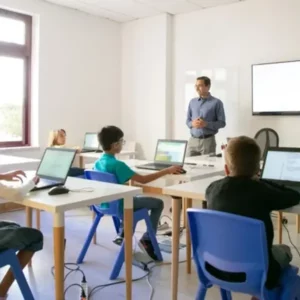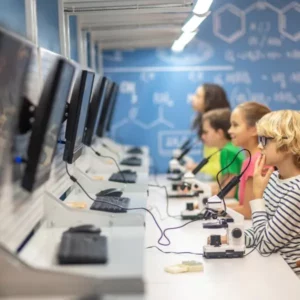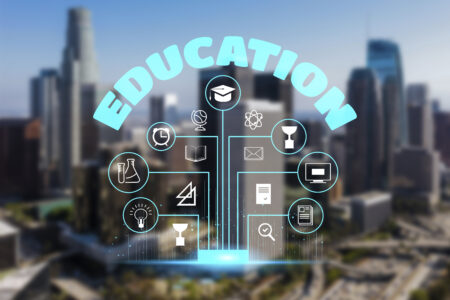In today’s fast-paced digital age, technology has become an indispensable part of our lives. From the way we communicate to how we work, it has revolutionized every aspect of our daily routines. One area where technology’s impact is increasingly evident is education. With the advent of tech-driven learning, students and teachers alike are experiencing a paradigm shift in the way knowledge is acquired and disseminated.

The Role of Technology in Education
Education and technology have merged to create a powerful synergy, propelling the learning process to new heights. In the traditional classroom setup, teachers rely on textbooks, whiteboards, and face-to-face interactions to impart knowledge. While these methods have their merits, they may not always cater to the diverse learning needs of students.
Incorporating technology in education has opened up a world of possibilities. With digital devices such as laptops, tablets, and smartphones, students have access to a vast repository of information at their fingertips. The internet has become a treasure trove of knowledge, enabling students to explore subjects beyond the confines of their textbooks.
Advantages of Tech-Driven Learning
1. Personalized Learning
One of the most significant advantages of tech-driven learning is its ability to cater to individual learning styles and paces. Every student is unique, and traditional teaching methods may not address their specific needs. However, with adaptive learning platforms, students can progress at their own speed, ensuring a deeper understanding of the subject matter.
2. Interactive Content
Gone are the days of passive learning; technology has made education interactive and engaging. Educational software and applications offer multimedia content, including videos, animations, and simulations. This dynamic approach captures students’ attention and helps them retain information more effectively.
3. Access to Global Knowledge
The internet has turned the world into a global village, and students can now access information from any corner of the globe. This interconnectedness opens up new perspectives and fosters a deeper appreciation for cultural diversity.
4. Enhanced Teacher-Student Collaboration
Technology acts as a bridge between teachers and students, fostering better communication and collaboration. Learning management systems, virtual classrooms, and messaging apps facilitate seamless interaction, enabling teachers to provide timely feedback and support.
5. Constant Innovation
The field of technology is ever-evolving, and its integration in education ensures that the learning process remains dynamic and up-to-date. With the emergence of new tools and techniques, educators can continually enhance their teaching methods to deliver a better learning experience.
Challenges in Tech-Driven Learning
While tech-driven learning offers numerous benefits, it is not without its challenges. Addressing these concerns is crucial to ensure that technology remains an asset rather than a hindrance in the educational landscape.
1. Digital Divide
Not all students have equal access to technology and the internet. The digital divide creates disparities in learning opportunities, making it essential for educational institutions to bridge this gap and ensure that all students have access to the necessary resources.
2. Distractions and Misuse
The abundance of digital devices can lead to distractions and potential misuse in the learning environment. Students may get tempted to engage in non-educational activities, affecting their focus and academic performance.
3. Privacy and Security
The integration of technology in education requires safeguarding sensitive data and maintaining student privacy. Educational institutions must implement robust security measures to protect students’ personal information from potential cyber threats.
4. Over-Reliance on Technology
While technology is a valuable tool, over-reliance on it may overshadow the importance of traditional teaching methods. Striking the right balance between tech-driven learning and conventional techniques is crucial to ensure a well-rounded education.
The Future of Tech-Driven Learning
As technology continues to evolve, so does its impact on education. The future of tech-driven learning holds even more promise and potential.
1. Artificial Intelligence (AI) Integration
AI-driven educational platforms are set to transform the learning experience further. These systems can analyze student data, identify areas of improvement, and provide personalized learning paths, making education even more adaptive and effective.
2. Virtual Reality (VR) and Augmented Reality (AR)
VR and AR technologies have the potential to create immersive learning experiences that transcend the boundaries of traditional classrooms. Imagine students exploring ancient civilizations in history class or conducting virtual science experiments in a safe and controlled environment.
3. Gamification
Gamification techniques can revolutionize the way students engage with educational content. By incorporating elements of gaming, learning becomes enjoyable, motivating students to actively participate and excel in their studies.
4. Continuous Professional Development for Teachers
As technology evolves, teachers must keep pace with the latest trends and tools to deliver effective instruction. Continuous professional development programs will become increasingly important to empower educators with the necessary skills and knowledge.
Conclusion
In conclusion, tech-driven learning such as smart classroom is reshaping the educational landscape, empowering both students and teachers. The integration of technology has brought about personalized learning experiences, interactive content, and global connectivity. While there are challenges to overcome, the future of tech-driven learning holds tremendous promise with advancements like AI, VR, AR, and gamification. Embracing these innovations while addressing potential pitfalls will pave the way for a more dynamic and effective education system.










